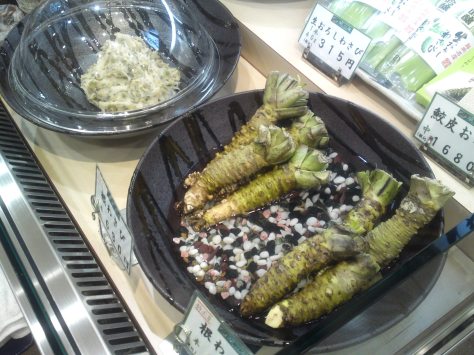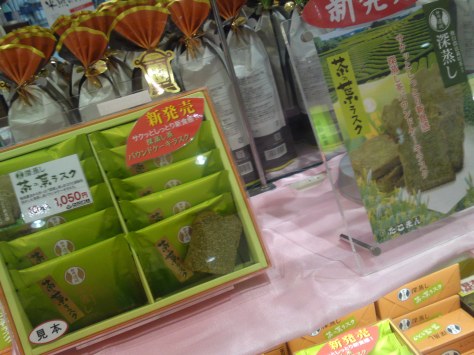Half way along our trip riding the Tenhama private Railway Line the other day we decided to pay a visit to the Fruits Park of Hamamatsu City.
We had only one hour until the next train and the walk to the Fruits Park takes 10 minutes.
We knew we would be limited in time and the blistering heat didn’t help!
At least looking at the pavement we knew we couldn’t lose our way!
The main entrance
The park is truly enormous and the car park is even bigger.
We realised that we had to limit this visit to the main attraction, the Tropical Fruit Dome!
The hall leading to the dome was full of information but the air-conditioning did not prepare us to the heat inside the dome!
By the way if you can read japanese check their HOMEPAGE as it will help you recognize some very strange fruit!
What is this fruit?
The temperature inside must have been well above 30 degrees with an incredible humidity.
The sweat prevented me to jot down notes and I’m afraid I don’t remember the names of some fruits! Let’s see if you can help me!
Fortunately there was plenty of running water to help cool down the dome!
Not only tropical fruit, but also plenty of beautiful flowers!
All in all, 80 varieties for 300 trees and plants!
Cocoa!
Start of the quizz!
What’s the name of those flowers?
What’s that fruit?
And what are these?
I’ve seen these flowers before…
It’s not a pineapple. What could it be?
Limes/ I doubt it…
Now, this a lime!
I’ve seen that one before, too!
Beautiful orchids there!
A pineapple!
What are these fruit?
Another pineapple!
Bananas!
Red bananas!
Insects and pests had better beware!
Banana flower!
Papaya!
More papayas!
And another pineapple!
Outside the dome a cafe/restaurant will welcome you inside a beautiful park.
But actually the Tropical Fruit Park and the big park with ponds outside represent only one fourth of the whole complex!
You will have to plan half a day for a complete visit even with the help of a mini train!
Among others, you will discover fields of plum trees, orange trees, apple trees, strawberries, grapes, blueberries, kiwi fruit, almond trees, figs, peach trees, pomegranate trees, a field of nut trees including chestnuts and a lot more inside greenhouses and experiment fields!
This park will warrant a least a couple more visits to describe it all!
FRUITS PARK
431-2102 Hamamatsu City, Kita Ku, Miyakoda Cho, 4263-1 (get down at Fruits Park Station on the Tenhama private Railway line. 10 minute walk)
Tel.: 053-428-5211
Fax: 053-428-52000
Business hours: 09:00~16:30 (October~April), 09:00~17:00 (May~September)
HOMEPAGE (Japanese)
RECOMMENDED RELATED WEBSITES
My White Kitchen, 47 Japanese Farms Through The Eyes of Its Rural Communities, Foodhoe, Chucks Eats, Things that Fizz & Stuff, Five Euro Food by Charles,Red Shallot Kitchen by Priscilla,With a Glass, Nami | Just One Cookbook, Peach Farm Studio, Clumsyfingers by Xethia, PepperBento,Adventures in Bento Making, American Bent, Beanbento, Bento No, Bento Wo Tsukurimashou, Cooking Cute, Eula, Hapabento , Happy Bento, Jacki’s Bento Blog, Kitchen Cow, Leggo My Obento, Le Petit Journal Bento & CO (French), Lunch In A Box,
Susan at Arkonlite, Vegan Lunch Box; Tokyo Tom Baker, Daily Food Porn/Osaka, Only Nature Food Porn, Happy Little Bento, The Herbed Kitchen, J-Mama’s Kitchen, Cook, Eat, Play, Repeat, Bento Lunch Blog (German), Adventures In Bento, Anna The Red’s Bento Factory, Cooking Cute, Timeless Gourmet, Bento Bug, Ideal Meal, Bentosaurus, Mr. Foodie (London/UK), Ohayo Bento,
Must-see tasting websites:
-Sake: Tokyo Through The Drinking Glass, Tokyo Foodcast, Urban Sake, Sake World
-Wine: Palate To Pen, Warren Bobrow, Cellar Tours, Ancient Fire Wines Blog
-Beer: Good Beer & Country Boys, Another Pint, Please!
-Japanese Pottery to enjoy your favourite drinks: Yellin Yakimono Gallery













































































